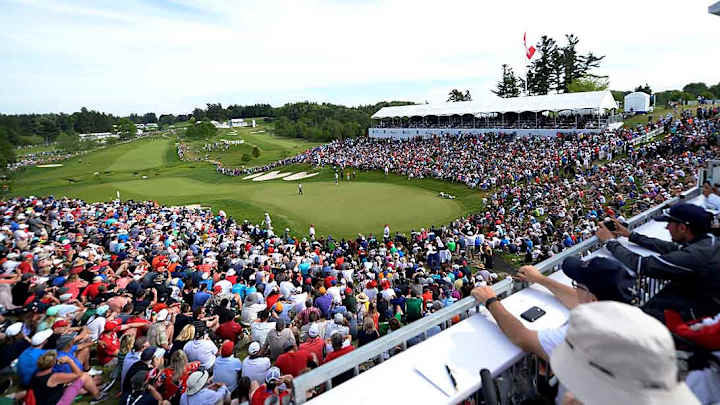Changes to the PGA Tour Are Here. We'll Have to Wait and See If They're Enough

Let’s start here: The PGA Tour had to change if it wanted to, you know, exist. Most of the top players in the world have resisted the call of Saudi government money to stay on the Tour, but enough have left that the ones who stayed have leverage. They wanted change, and more to the point: They wanted these changes. PGA Tour commissioner Jay Monahan could have said no, but then he probably wouldn’t be commissioner for long.
So here is the big change: Two tiers of tournaments, one of “elevated events” featuring the best players in the world and larger purses, and one for everybody else on Tour. It’s not quite that simple, and of course players can move up and down based on how they play each year. But that is the gist of it. The Tour also doubled its Player Impact Program payout from $50 million to $100 million.
This will all be better for the best players, and the Tour had to keep the best players. But whether it is better for the sport is to be determined. The fun part of this conversation—and the risk for Monahan and the Tour—is that nobody really knows how it will play out. There will be unintended consequences and necessary tweaks.
Rory McIlroy pointed out that when you watch the Tampa Bay Buccaneers, you expect to see Tom Brady. There is a lot to be said for giving viewers and sponsors certainty about which stars will show up. So now top players are committing to 20 mostly elevated events. That is a lot. After this week’s season finale at East Lake in Atlanta, Jon Rahm will have played 19 events this year, Patrick Cantlay will have played 20, Scottie Scheffler will have played 25, and Jordan Spieth will have played 22. Having them all play 20 events together sounds great, because it is great. But it comes with a pretty obvious price: They won’t really play much anywhere else.
When the Tour goes to a 35-event schedule, that leaves 15 events scrambling for relevance. If you define the PGA Tour’s product by how often the best players face each other, then the product just got better. But if you define it by how often you get to see the best players, the product just got worse. There will now be a couple dozen weeks on the calendar when you can be pretty sure nobody in the top 20 is playing.
We’ll see how this plays out. But if you grant the idea that the PGA Tour needs to do right by its best players, as a matter of principle as well as survival, it is fair to wonder if there were better and simpler ways to do this.
Counting the Player Impact Program, which is basically an annual $100 million popularity contest, the Tour is trying to funnel a ton of money to its best players. Here is a crazy idea: Just award it to the best players! Forget the PIP and the extra exclusive events. Create a bonus system so that the top-performing players over the course of a season earn more money. For example: Scottie Scheffler is first on the money list this year with $14 million. What if, instead of throwing $10 million at whoever finishes first in the PIP, Scheffler got a $10 million bonus for finishing first on the money list? That would make the No. 1 player in the world happy and it would be true to the principle that has defined the PGA Tour forever: You earn it on the course.
That sounds better than the current plan, at least to me. But there is a problem with that, too, and his name is Tiger Woods. Woods won’t play 20 events. He will probably never be one of the top 20 performers on the course in a given year again. And yet, whenever he does play, that is by definition one of the biggest events of the year. The Tour needed to find ways for Woods and other huge names to play in elevated events. Tying the field to PIP does that.
This was also a chance to rethink the FedEx Cup, a good idea in its 16th year of middling execution. The Tour has tried all sorts of gimmicks to make the playoffs seem like playoffs. The current iteration allows players to earn points over the full season, then use the first two FedEx Cup tournaments to position themselves for the third.
This leads to a finale that is actually designed to be anticlimactic. This week, thanks to his season-long dominance, Scheffler starts the Tour Championship with a two-shot lead. Only four players are within five shots of him. The best team in the NFL does not start the Super Bowl with a 10-point lead.
It would be so much better to follow what other sports do and allow players to clinch byes by playing well all year. If you’re in the top 10 in the standings on Aug. 1, you clinch a playoff spot. The next group of players in the standings has to earn their way into the Tour Championship in the playoff events—but the top players can play in those events too, earning more money and climbing up the money list, triggering those bonuses I mentioned earlier. Then, when the Tour Championship starts, everybody who made it begins at even par.
I bring this up because the PGA Tour is making a big deal out of getting its best players together in the same week, but here they are all playing together this week, and the Tour is trying to eliminate some of them before they tee off. Golf is so strange.
Anyway: these are massive changes for the PGA Tour, but change was necessary. We will see, over time, if these were the right changes.
